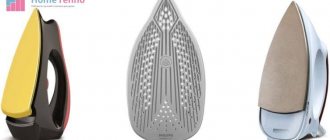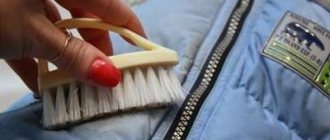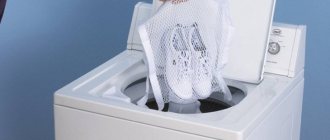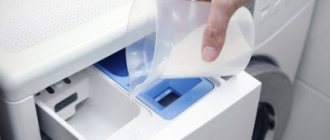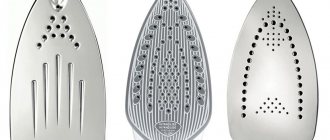Outsole material
First, let's talk about what material the sole of your iron can be made of. It depends on the material which recipes you can use to clean the soleplate of your iron at home.
And which ones cannot be used, because... they may damage the device.
Manufacturers choose the following materials:
- Aluminum . Perhaps one of the most popular materials, because... it belongs to the budget category. Aluminum also conducts heat well, is lightweight, but cannot be said to be durable and reliable. For example, an aluminum sole can leave a hole in a T-shirt if the temperature is not adjusted correctly. And you can’t iron the wool at all.
- Stainless steel . The iron will cost more, but its quality will be better. The sole heats up evenly, which minimizes the possibility of damaging the fabric. Stainless steel is durable and resistant to rust and damage. Therefore, you can safely choose even rough cleaning of the iron to remove burnt marks on the sole.
- Ceramics . It glides easily, removes wrinkles well and heats up evenly. Also, threads and fibers do not collect on the sole, and there are no puffs left on clothes.
- Teflon . A good iron for delicate items. But you also need to handle it carefully, because... Scratches may appear on the surface, and Teflon itself wears off faster than other materials.
All the recipes that we will discuss below are suitable for cleaning the ceramic soleplate of an iron.
But to clean the soleplate of a Teflon-coated iron, pay attention to only two methods:
- Pencil.
- Vinegar 70%.
How to care for your iron and prevent carbon deposits
When using the device, you should not deviate from the manufacturer’s recommendations regarding operating features. It is necessary to monitor the temperature conditions of the device when processing silk and synthetic fabrics. Only clean items can be ironed. Do not leave the device on the fabric for too long a period when ironing.
After each use, when the surface temperature drops, it should be wiped with a damp cloth. If thorough cleaning is necessary, you should choose a product based on the type of coating so as not to damage it.
Recipe 1: Clean the soleplate of the iron with salt
Ingredients:
- Salt.
- A blank sheet of paper or cardboard.
How to clean the soleplate of your iron with salt:
- Spread the salt in one layer on a clean sheet of paper or cardboard.
- Split the iron.
- Run the iron over the salt scattered on the sheet, pressing the soleplate firmly. The salt will remove all the carbon deposits from the surface.
Important! Please note that this recipe is not suitable if you need to clean the soleplate of a Teflon iron. Because Coarse salt can scratch it.
Recipe No. 2. How to clean the soleplate of an iron with vinegar?
Ingredients:
- Vinegar.
- Cotton wool, cloth or towel.
- Water.
How to quickly clean the soleplate of your iron with vinegar:
- Option 1 . Soak cotton wool in vinegar and wipe the areas where the burnt marks appear. There is no need to turn on the iron.
- Option 2 . Soak a cloth in vinegar and place a warm, but not turned on, iron on it. Leave the device in this position for several hours. And then wipe dry with a clean cloth.
- Option 3 . Combine 2 tbsp. l. vinegar with a glass of water. Soak a towel in the solution and iron it with an iron operating at medium heat. The best option for large stains.
This recipe is suitable for cleaning the ceramic soleplate of an iron, as well as Teflon, if you use 70% vinegar.
Methods for cleaning durable coatings
When cleaning durable titanium, steel, sapphire and enamel coatings, even aggressive and abrasive agents can be used.
To clean irons with these types of soles, you can use a powder or toothpaste that contains abrasive particles. The device needs to be warmed up a little. The surface should be warm, but not hot. Use a brush, onto which 2-3 cm of paste is previously applied, to clean the sole. The surface is wiped with a damp cloth to remove any remaining paste. Then it is thoroughly rubbed with a dry cloth.
In addition, heavy carbon deposits can be removed with a mixture of soda and detergent in a 2:1 ratio. The gruel is applied to a cold surface. Then the surface is cleaned with a sponge. Remains of product and dirt are removed with a damp cloth.
Durable surfaces can be cleaned with salt. To do this, salt is poured onto the cotton fabric so that it is completely covered. Then you need to warm up the device as much as possible and place its sole on the salt. After 2-3 minutes, you should remove the parting, brush off the stuck salt, and then iron it with a stiff cotton cloth. For better results, all steps must be repeated.
If carbon deposits on the surface are caused by contact with synthetics, the contamination can be removed using another aggressive method. First, the remains of burnt synthetics should be cleaned off the heated surface. Then, with the device heated to maximum, you should iron the old, rough towel. This will remove any remaining contamination.
Recipe No. 3. How to clean the soleplate of an iron with soda?
Another remedy that you always have at home is baking soda. It will also cope with cleaning the soleplate of the iron from carbon deposits.
What to take:
- Baking soda (plus extra hydrogen peroxide).
- Water.
- Capacity.
How to clean the soleplate of an iron with soda:
- In a container convenient for you, combine baking soda and water, you should get a thick paste.
- Rub the mixture into the sole.
- Then rinse the solution with water and wipe clean.
Second way:
- Heat the iron to the highest possible temperature.
- Soak the sole with peroxide.
- Wait until it cools down.
- Apply a mixture of baking soda and water to the cold sole.
- Wait about 7 minutes. and rinse off the residue, and then wipe the surface with a clean cloth.
Important! We remember that soda is contraindicated for cleaning the soleplate of a Teflon-coated iron.
Newspaper and salt - the Soviet way
Life hacks from Soviet life, in which housewives were not spoiled with auxiliary cleaning products from the store, are quite applicable to this day.
- Simple table salt and newspapers can also help in cleaning the iron.
- It must be set to the highest temperature and newspaper laid out on the ironing board.
- You should sprinkle a large amount of salt on the newspaper and iron the “salted” newspaper in a circular motion until it becomes clean.
- If you don't have newspaper on hand, you can use a brown paper bag or wrapping paper.
This method is quite suitable if the sole is not too dirty.
Recipe No. 4. Cleaning the soleplate of the iron with laundry soap
It will help if you decide to clean the ceramic sole of your iron at home, but the carbon deposits on it are not strong.
What to take:
- Laundry soap.
- Warm water.
- Capacity.
- A napkin or cotton swab, cotton swabs.
How to clean the soleplate of an iron with laundry soap:
- Preheat the iron at minimum temperature.
- Rub the surface with a bar of soap.
- Wait until the soap softens the carbon deposits.
- Remove soap residue with a napkin or disk, and treat the steam holes with a cotton swab.
Second way:
- Dissolve crushed pieces of soap in warm water.
- Use a napkin to wipe off the soot as much as possible.
- Apply a soap solution to a dry sole heated at a minimum temperature.
- Wait 20 min.
- Wipe the surface with a clean cloth.
How to clean the inside of an iron from scale using traditional methods
If the iron is equipped with a steam generator, then it is only a matter of time before scale appears inside it. Steam is formed during the boiling process of water in a special tank, and even if the water is of very high quality, over time it will still leave a solid residue on the walls of the tank. You can clean the iron steamer from scale without disassembling the device; just pour a special product into the steam generator that dissolves deposits well.
How to remove scale from an iron with vinegar
An excellent household product for cleaning scale is table vinegar with a concentration of 9%. The solution allows you to cope even with old deposits and helps clean minor formations.
You can descale your iron at home using vinegar as follows:
- Half a glass of table vinegar is diluted with an equal amount of filtered water.
- The solution is poured into the steam generator tank, approximately 1/3 of the capacity; there is no need to fill the container completely.
- The iron is placed vertically, plugged into an outlet, and then the maximum power of the device is set to strongly heat the sole.
- The device is kept in this mode for about 10 minutes.
After the time has passed, you need to place a basin under the sole of the device and press the steam button. After all the vinegar water has drained out, you will need to fill the container with ordinary clean water and repeat the entire procedure from the beginning, this is necessary to remove any remaining vinegar from the reservoir.
The cleaned iron is unplugged from the outlet and wait until the sole has cooled completely. After this, wipe it with a dry cloth and do not use the device for some more time; you need to wait until the water even inside is completely dry.
How to remove scale from an iron with citric acid
Another effective solvent for cleaning the internal system is citric acid. Due to its caustic composition, it perfectly dissolves solid deposits and helps prevent device damage or deterioration in performance:
- To clean the iron with citric acid, you need to pour 25 g of powder into a glass of hot water and stir thoroughly.
- After this, the liquid is poured into the reservoir without filling it to the top, the device is plugged into an outlet and installed vertically.
- At maximum power, the device is heated for 10 minutes, and then steam and liquid are released from the reservoir into a substitute container.
After all the lemon solution has flowed out, the tank will need to be filled with filtered clean water and repeat the procedure again. If you do not do this, acid residues may linger in the tank, and then the clothes will be damaged during the next ironing session.
Recipe No. 5. How to clean the soleplate of an iron with toothpaste?
Cleaning the soleplate of your iron with toothpaste is very easy.
What to take:
- I love any toothpaste.
- Brush or soft cloth.
- A napkin.
How to clean the soleplate of your iron with toothpaste:
- Apply the paste from the tube to the contaminated areas of the sole.
- Rub with a toothbrush or cloth until clean.
- Wipe the surface clean with a damp cloth.
This method is best suited if you are thinking about how to clean the soleplate of a ceramic-coated iron.
The final. Best Pollution Control Products by Category
The time has come to summarize all the information collected and decide on the winners in various “categories”. Our editors recommend that you first take a closer look at these means and methods.
How to descale an iron: TOP 3 best
| № | Method | Advantages | Editor's rating, point |
| 1. | "Cillit" | Efficiency, additional properties, versatility. | 9,7/10 |
| 2. | Vinegar | Availability, natural ingredients. | 9,5/10 |
| 3. | Lemon acid | Price, wide range of uses. | 9,4/10 |
How to clean an iron from carbon deposits: TOP 3 best
| № | Method | Advantages | Editor's rating, point |
| 1. | Special pencil | Versatility, ease of use. | 9,9/10 |
| 2. | Toothpaste | Availability, wide range of uses. | 9,6/10 |
| 3. | Acetone | Availability, efficiency, price. | 9,3/10 |
Recipe No. 6. Cleaning the soleplate of the iron with a pencil
You can buy a pencil at a hardware store. But before you clean the soleplate of the iron with a pencil, read the instructions that come with it.
It is also better to carry out the procedure in a ventilated area, because... Substances contained in the pencil may evaporate and produce harmful smoke.
What to take:
- Pencil.
- Soft napkins or cloth.
How to clean:
- Preheat the iron to the temperature specified in the instructions for the pencil.
- Use a pencil to work on the problem areas on the sole. But do not press too hard so that it does not crumble under your fingers. Otherwise, pieces of pencil may get into the steam holes and the operation of the iron will be disrupted.
- The pencil will melt under the influence of temperature.
- Use a soft cloth or rag to remove any remaining dirt, and after the iron has cooled down, wipe the surface with a dry and then a wet cloth.
Suitable for cleaning the soleplate of an iron with any coating: ceramics, metal, Teflon.
Types of iron coatings
Before dealing with dirt, it is necessary to determine what the sole of the device is made of, otherwise you can ruin the surface.
The coatings are as follows:
- Titanium;
- Enameled;
- Aluminum;
- Ceramic;
- Made from stainless steel.
If the coating of the iron is damaged, it will perform its functions worse or become unsuitable for use.
Titanium coated sole
The most expensive but durable material for making iron soles. It is not subject to mechanical stress, does not burn, and takes a long time to heat up. The advantage of titanium coating is that when cleaning it, you can use soft brushes, spatulas or scrapers, ammonia, and vinegar. It is practically not subject to erosion.
Enameled coating
The enamel is highly resistant to mechanical stress in the form of scratches and cracks, but if handled poorly, cracks may appear on the sole and the enamel will delaminate. Cleaning such a coating can be done with soda, a special pencil, vinegar, etc.
Aluminum coating
The advantages of aluminum are that this material is low in price, lightweight and heats up well. Its main disadvantage is that it is easily deformed and scratched. Due to the appearance of cracks, the quality of ironing decreases. Dirt gets into microcracks, which is difficult to get rid of, since the use of brushes is not recommended.
Ceramic coating
This coverage is ambiguous. Carbon deposits rarely form on ceramic coatings, but scale is a common occurrence for them. For this reason, it is recommended to pour boiled or filtered water into the device. Ceramics is a fragile material that requires careful care.
Stainless steel coating
Stainless steel cannot be touched with metal objects, so carbon deposits can only be removed with a wooden spatula. Housewives most often clean soles made of this material with abrasive agents.
Recipe No. 7. Cleaning the soleplate of the iron with a candle
An analogue of a pencil for quickly cleaning the soleplate of an iron at home is the usual paraffin candle. But it can handle light stains.
What to take:
- A candle.
- Fabric or paper.
- A napkin.
How to clean the soleplate of an iron with a candle:
- Heat the iron to a high temperature, but you will have to select it experimentally.
- Wrap the edge of the candle that you hold in your hand in cloth or paper.
- Apply the candle to the surface of the iron, but hold it at an angle to prevent wax from getting into the holes.
- Let the device cool down.
- Remove any remaining wax and dirt with a napkin.
The magic of the melamine sponge
The melamine magic eraser, which became popular in households a few years ago, can work wonders on your iron. By wetting a melamine sponge and carefully wiping the cold sole of the device with it, you can quickly get rid of all unnecessary dirt and mineral deposits.
The rules for working with melamine sponge are as follows:
- Do not use it on a hot and heated surface (melamine produces harmful fumes when heated);
- Do not use it with other cleaning products;
- It is preferable to use household gloves to prevent irritation of the skin of the hands;
- Melamine sponges should not be left within the reach of children and animals.
The melamine sponge is very effective for cleaning irons and other household products, but it is necessary to wipe the surfaces cleaned with cold water to remove invisible residues of melamine foam.
Recipe No. 8. Cleaning the soleplate of the iron with hydrogen peroxide and ammonia
What else can you use to clean the soleplate of your iron? Peroxide and ammonia!
What to take:
- Hydrogen peroxide.
- Ammonia.
- Water.
- Capacity.
- Textile.
How to clean the soleplate of an iron with hydrogen peroxide and ammonia:
- Mix five drops of ammonia and half a glass of water in a container.
- Wipe the base of the device with the solution.
- Dry with a cloth.
Melted plastic
If the iron comes into contact with polymer materials, causing them to stick to the bottom, you should immediately unplug it. Then you need to lower the iron onto the ice (for example, put ice cubes from the freezer in a frying pan and place the soleplate there) so that the plastic quickly hardens.
After this, just take a plastic knife from a set of disposable tableware and carefully scrape off the melted polymer material, then wipe the surface with vinegar. Before using the iron further, it is very important to remove all plastic, otherwise it will remain on the clothes being ironed and will be almost impossible to remove.
Recipe No. 9. How to clean the soleplate of an iron with solvent?
This recipe will help not only clean the iron from burnt soles, but also get rid of delicate fabric, polyethylene, etc. stuck to the surface.
What to take:
- Nail polish remover or B-47.
- A cotton pad or fabric made of natural material.
How to clean the soleplate of an iron with solvent:
- Dampen the disc or cloth with solvent.
- Wipe the cold soleplate of the iron.
- Remove any residue with warm water and wipe the surface dry.
Important! During the procedure, the surface of the iron should be cold.
Prevention and care tips
To avoid cleaning your iron so often from carbon deposits on the soleplate, follow the following preventive measures and listen to the advice:
- If you suddenly make a hole in the fabric and it sticks to the sole, apply cotton soaked in cold water to this place. This will help peel the fabric away from the sole.
- When cleaning, do not use rough brushes, sponges, napkins, etc. Especially when it comes to ceramics or Teflon.
- Avoid abrasive cleaners.
- Do not leave water in the iron after ironing; drain it into the sink.
- Use clean water, not tap water.
Preventive measures and recommendations
Cleaning an iron with scale holes is quite simple. But if you follow simple recommendations, then in principle you will not have to service the device so often:
- The tank of the steam device should be filled with filtered water or diluted with distilled water in a 1:1 ratio.
- At the end of ironing, the tank must be emptied. The longer the water remains in it, the faster a whitish coating appears on the walls of the container.
- Distilled liquid can be diluted with regular liquid, but it is not recommended to use it in its pure form for ironing. It boils more slowly and produces steam less well, and this harms the internal parts of the iron.
It is necessary to clean the device from lime deposits immediately after white marks appear. The thinner and weaker the layer of scale, the easier it will be to remove it using folk and professional means.
After self-cleaning, it is advisable not to use the ironing unit for 1-2 days.
